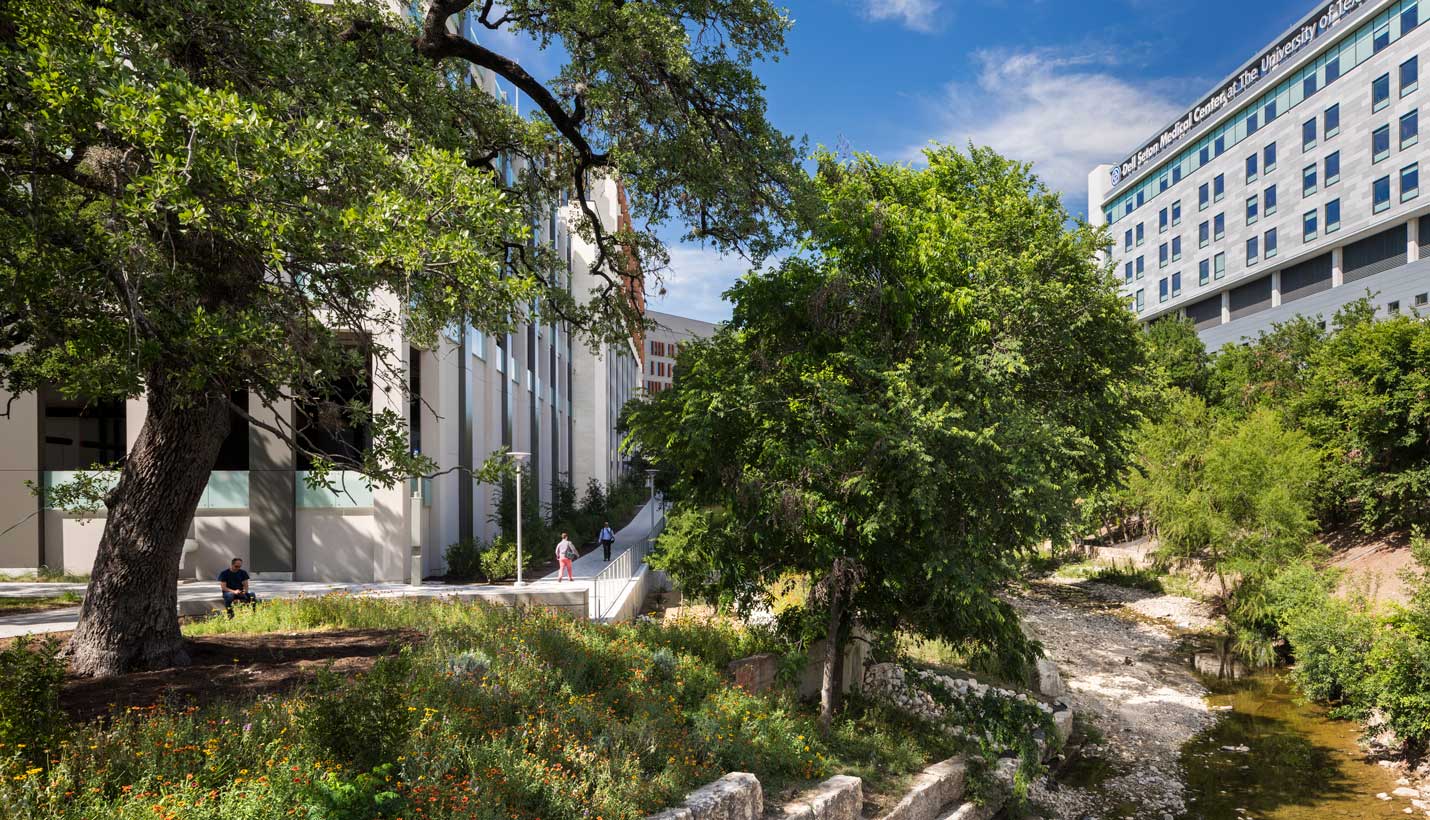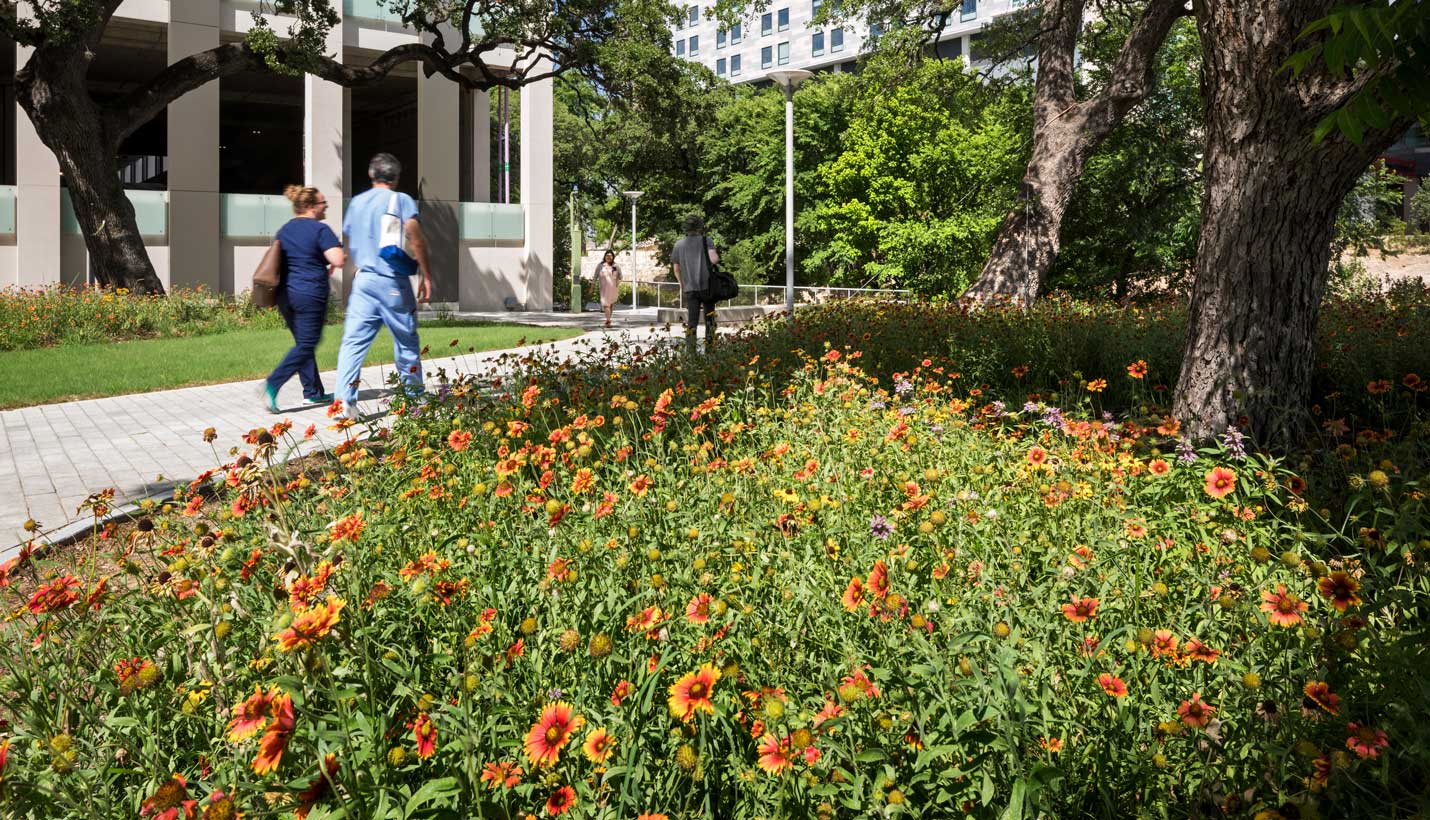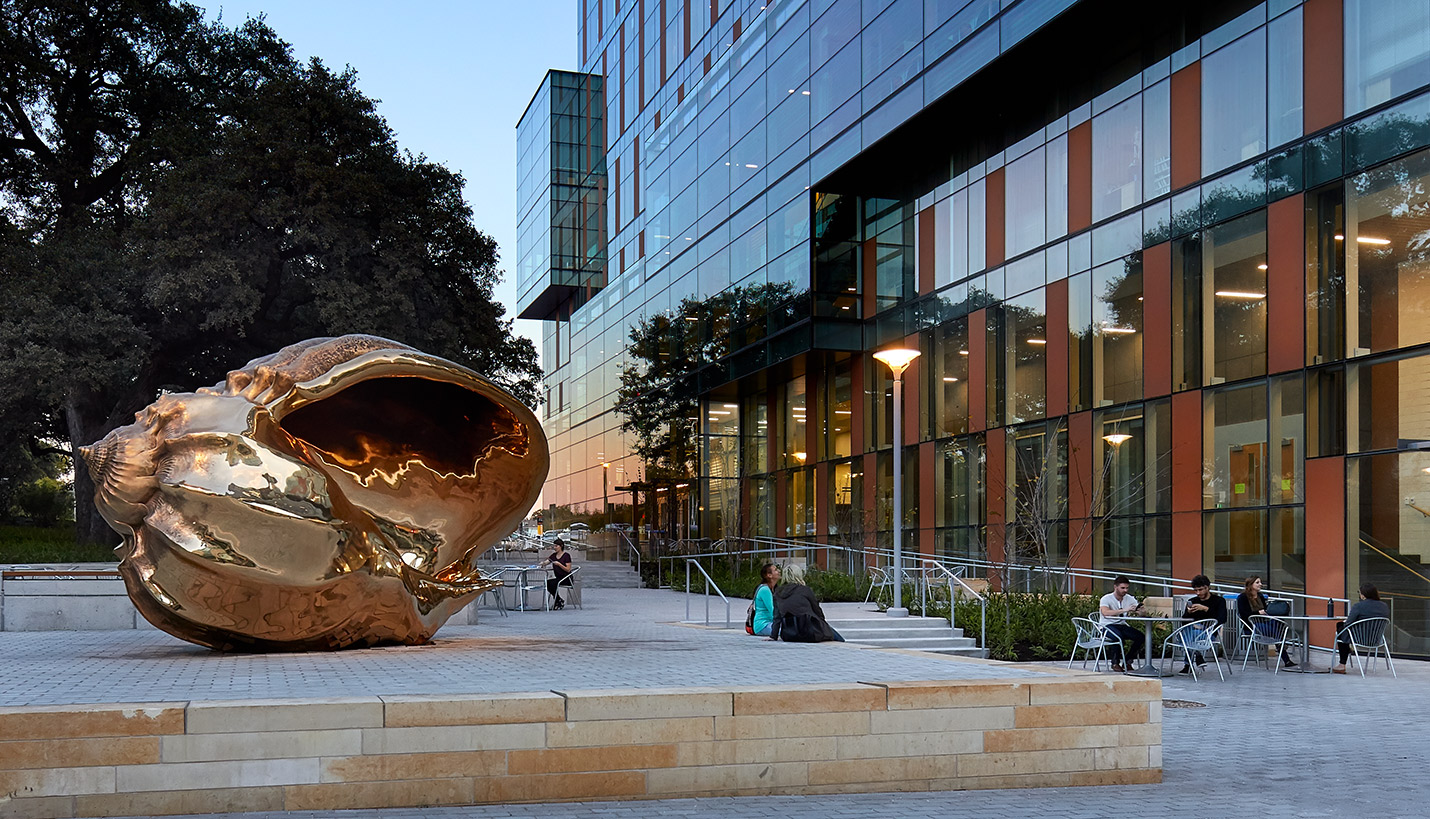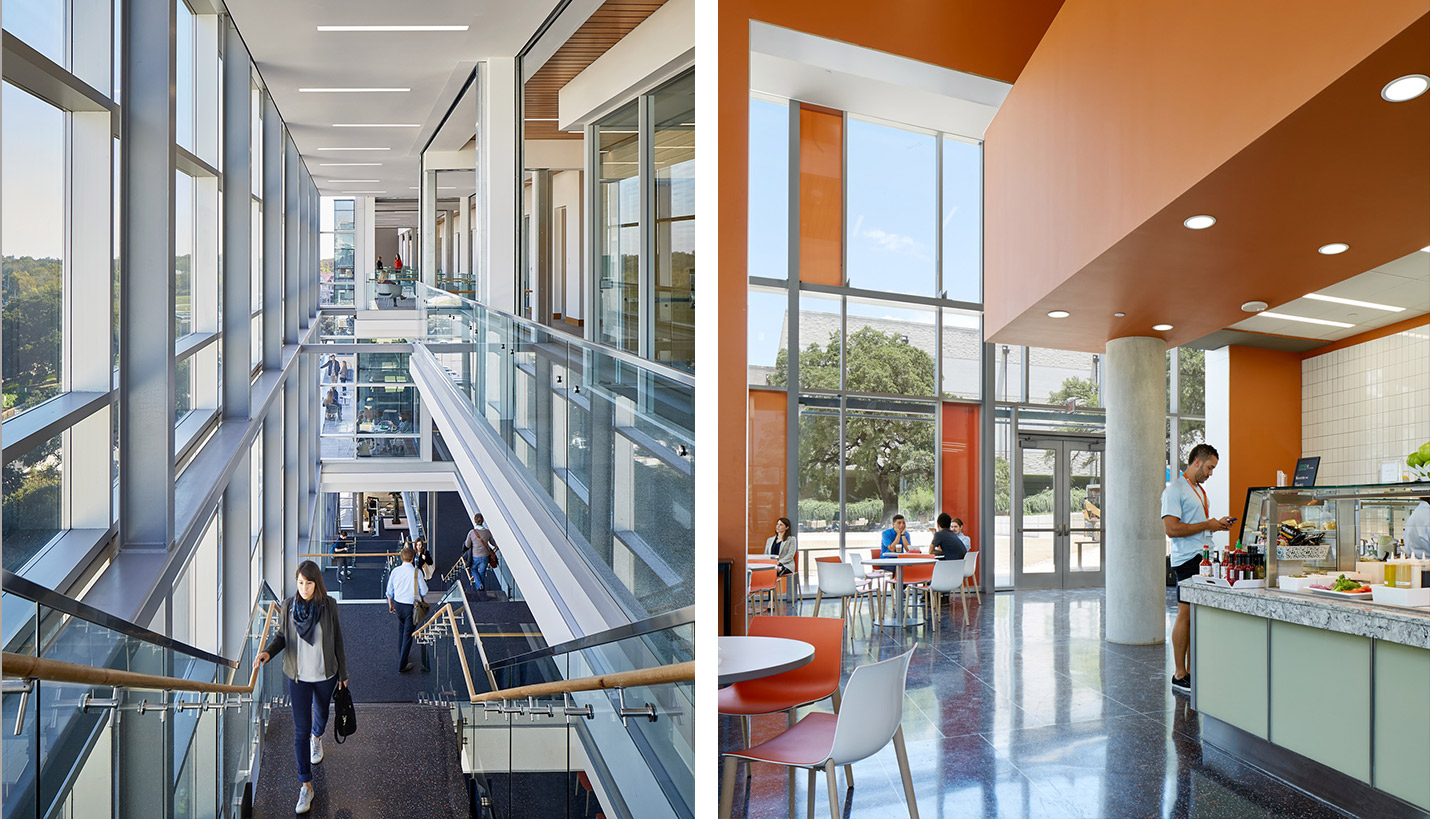






A District Built For Health
The Dell Medical School (DMS) District is one of the few districts recognized by Sustainable SITES Initiative. It is composed of 16.2 acres in central Austin traversed by an urban stream. A variety of ecological and health oriented sustainable features in the landscape design contributed to the SITES recognition.
The health district’s formal plantings make it an urban, native plant oasis that provides ecological and health benefits while reducing irrigation needs by over 75%.The project manages the 80th percentile rainfall event or approximately 46,939 cubic feet of water through a combination of rain gardens, pervious pavers, rainwater harvesting, and a green roof. Stormwater management features were designed as site amenities to connect visitors to the local climate and hydrology. Outdoor water use has been reduced by over 75% through careful plant selection, soil restoration, real-time irrigation monitoring, and reuse of rainwater and A/C condensate. The Waller Creek corridor was 100% restored to native plant communities representative of the Edwards Plateau and Blackland Prairie ecosystems. The project reduced the energy used for transportation, promoted regional identity and supported the local economy because 68% of materials costs went towards regional materials. The University successfully relocated 12 trees, including nine heritage live oaks, from building pad sites. The site will be maintained with manual or electric powered rather than fossil fuel powered equipment.
LEED Gold certified, the 85,000-square-foot Health Learning Building design is based on the inextricable link between learning, health and the built environment. For the Health Learning Building, the project team utilized a whole building approach to energy modeling and life cycle cost analysis to evaluate energy strategies and design the building to achieve 44% energy savings. Among the many health and nature oriented sustainable features in the building are 1) natural light and nature views for almost all work spaces; 2) outdoor spaces on every floor with terraces on the lower floors oriented to the courtyard and on the top floor oriented to views of downtown Austin and the State Capitol; 3) all of the vegetation installed onsite is native and adaptive, resulting in restoration of 36% of the total campus site; 4) a monumental stair along the north glass wall to encourage occupants to move through the building using the stair rather than the elevator; 5) the building’s envelope has a 45% window to wall ratio but has an envelope design that is 50% better than baseline; 6) fresh outdoor air monitored to promote occupant comfort and healthy CO2 levels; 7) indoor finishes that are low-emitting healthy materials like terrazzo, no-VOC paints, CRI green label cradle-to-cradle silver certified carpets; 8) flexible furniture with adjustable height tables to accommodate active changes in work and study modes.
LEED Gold certified, the 260,000-square-foot Health Discovery Building provides state-of-the-art multi-disciplinary clinical research laboratories; laboratory support spaces, including a vivarium; faculty and student offices and administrative offices. For the Health Discovery Building, the project team sought to provide a high-quality environment for scientists, while also considerably reducing the building’s environmental impact and operations costs by reducing energy and water consumption.
Significant sustainable features in the building include 1) reduction of conditioning energy demand control ventilation, fume hood optimization and chilled beams (additional strategies include wall and roof insulation that exceeds the code requirements, reduced lighting power densities, appropriate daylight controls, and run-around loop heat recovery on all lab exhaust air); 2) natural light and views to the exterior in labs and offices 3) open offices and adjacent circulation with daylight-responsive lighting controls to reduce energy consumption; 4) 20% of total materials budget was dedicated to both recycled content and regionally sourced materials; 5) wood harvested from the site used for furniture and finishes within the building; 6) fresh outdoor air monitored to promote occupant comfort and healthy CO2 levels; 7) fully zoned exhaust areas separating potentially harmful gases from other systems; 8) indoor finishes that are low-emitting healthy materials like terrazzo, no-VOC paints, no added urea formaldehyde in any composite wood materials; 9) flexible control for temperature and lighting to accommodate active changes in work and study modes.
LEED Gold certified, the 233,000-square-foot, Health Transformation Building promotes the advancement of the medical office building concept and features a five-story dry lab linking the structure to the Health Discovery Building. Like its neighbor, sustainability strategy in the building focuses on reduction of water and energy consumption as well as the use of high-quality materials and design supporting optimal indoor air quality.
Among the many sustainable features in the building are 1) green roof and rainwater capture/recycling system that feeds into a cistern located in the building’s garage; 2) water consumption in the building was reduced more than 35% through installation of low-flow high-efficiency fixtures; 3) installation of efficient base building systems will result in energy cost savings of nearly 23% compared to national baseline; 4) design strategies supporting low energy use include daylighting controls (sensors that control electric lighting levels depend on amount of daylight in a space), lighting power reduction (elimination of need for electric lighting reduces consumption and cooling loads required to eliminate heat from lights) and efficient fan system; 4) all air monitored to promote occupant comfort and healthy CO2 levels; 5) indoor finishes that are low-emitting healthy materials like terrazzo, no-VOC paints, no added urea formaldehyde in any composite wood materials 6) 21% of building materials were derived from recycled sources, 38% from regionally available materials, and 94% of wood was from sustainably forested sources ; 7) 91% of construction and demolition waste was diverted from landfill through recycling or reuse; 8) flexible control for temperature and lighting to accommodate active changes in work and study modes.
Page is the design architect for the Health Learning Building, which serves as the educational center, in association with The SLAM Collaborative. Page is the architect of record in association with ZGF Architects on the additional two buildings, the Health Transformation and the Health Discovery Buildings. Sasaki is the lead consultant on the design team of the master plan, which Page was a part of as well.
10/14/2019
People
- Daniel Brooks
- Robert E. Burke
- Ginny Chilton
- Joshua D. Coleman
- Kregg Elsass
- Mattia J. Flabiano III
- Patrick Gurley
- Breanne Hanson
- Shawn-Marie Henson
- Jeffrey G. Jewesson
- Jill Kurtz
- Matthew Z. Leach
- Ryan Losch
- Joseph P. Moore
- Erin D. Nash
- Bryan O'Sullivan
- Freddy Padilla
- Dale Robinson
- Brian D. Roeder
- Sana Sabharwal
- Kimberly Schuessler
- Jerald L. Segner
- Jonah T. Sendelbach
- Talmadge Smith
- Lawrence W. Speck
- Wendy Dunnam Tita
- Randy C. Twedt
Related Posts
- Tempering the Temporary: Improving thermal comfort and safety in relief shelters
- Ushering in New Era of Science Research
- Nurturing Resiliency through Relationships
- Overview: Dell Medical School at The University of Texas at Austin Updates
- Winner: Community Impact Award
- New School of Thought at New School of Medicine
- Sustainability Design Leaders Tour Dell Medical School








